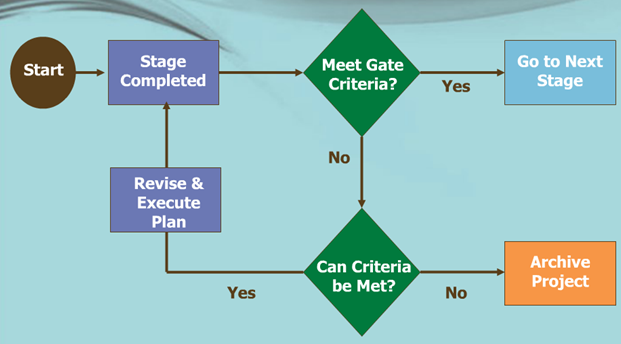
The NPD Process – It’s a Stage-Gate Thing
“The best performing companies’ new product development (NPD) revenues range from 20%-50% of total revenues and more for profit.” – NP Learning, LLC
Do I have your attention?
First a quick explanation of “stage-gate process”. The stages are the periods during which the actual work takes place and should include specific milestones. The gates occur between the stages and are the decision-making points. Common gate criteria include:
Project feasibility |
|
Stage 1: Opportunity Identification
This is when you identify potential markets, technologies and products that fit the organization’s strategy. The organization links the market and business strategic plans with the potential new product.
| Key Activities | Key Deliverables |
|---|---|
Technical feasibility |
|
Stage 2: Concept Generation
Activities focus on generating product ideas or concept that will meet the market needs found in Stage 1. No idea or concept is too outlandish at this stage.
| Key Activities | Key Deliverables |
|---|---|
Pursuing outside sources |
|
Stage 3: Concept Evaluation
At this point, you should be evaluating the concepts generated in stage 2 and select the most attractive of them for further development.
| Key Activities | Key Deliverables |
|---|---|
Define product attributes |
|
Stage 4: Development
Development of the new product is finalized and the product is manufactured. This should involve multiple personnel across several divisions. This stage may require investment for new facilities to produce the new product. Stage 4 is normally lengthier and more costly than the other stages.
| Key Activities | Key Deliverables |
|---|---|
Strategic launch planning |
|
Stage 5: Launch
This is, for many, the most exciting stage of the process since the new product is being commercialized. This stage involves everything necessary to launch the new product. Key activities are oriented around the launch and ensuring appropriate inventory exists for the new product as it goes into full sale.
| Key Activities | Key Deliverables |
|---|---|
Implement operations and ramp up to full-scale production |
|
Stage 6: Life Cycle Management
This stage involves monitoring the product for success in the marketplace and making any necessary adjustments to it in the event it is not performing as expected. This stage is the one most likely to be skipped in the NPD process.
| Key Activities | Key Deliverables |
|---|---|
Augment the product to create a new product line if needed |
|
Summary
Following a structured NPD process can improve time-to-market, decrease costs by allowing for the killing off of unfeasible products earlier on in the process, improve IRR and ROI and improve communication across all functional areas resulting in superior products that better meet customer needs. In the end, the question isn’t “Why use an NPD Process?” but rather “Why not use an NPD process?”
